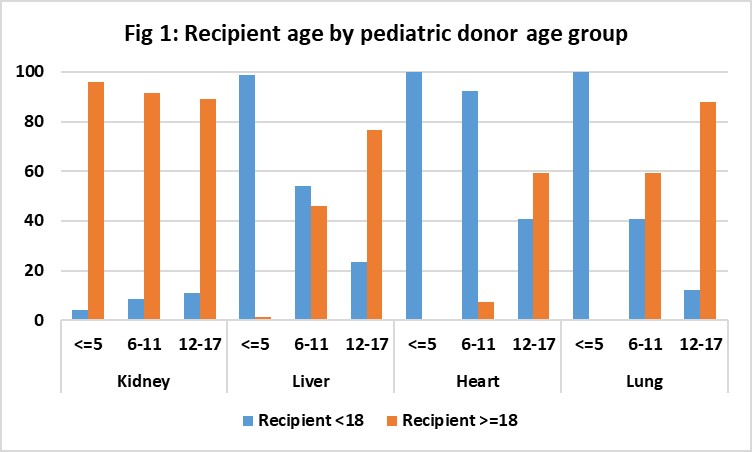To Whom do Pediatric Donor Organs Go?
1Seattle Children's Hospital, Seattle, WA, 2SRTR, Minneapolis, MN, 3Lurie Children's Hospital, Chicago, IL, 4Univ of Wisconsin, Madison, WI
Meeting: 2021 American Transplant Congress
Abstract number: 1018
Keywords: Allocation, Donation, Pediatric, Public policy
Topic: Clinical Science » Kidney » Kidney: Pediatrics
Session Information
Session Name: Kidney: Pediatrics
Session Type: Poster Abstract
Session Date & Time: None. Available on demand.
Location: Virtual
*Purpose: Pediatric priority in organ allocation is mandated by the Final Rule, but prioritization varies by organ, sometimes informed by size-matching needs. Heart (Policy 6.6.E) and lung (Policy 10.4.D) policy dictate that organs from donors <18 years be allocated to pediatric candidates before adults. Liver (Policy 9.8.F, 9.8.G) policy prioritizes pediatric candidates for pediatric donor organs. Kidney policy has no such priority. Moreover, the kidney profile donor index (KDPI, a measure of donor quality) is limited by the exclusion of pediatric recipients in the model. A high proportion of pediatric donor organs with KDPI >35% results in allocation of pediatric donor kidneys to adults. We wanted to determine how often pediatric donor organs go to pediatric recipients.
*Methods: We used SRTR data to classify donor and recipient age groups per organ. The cohort includes kidney, liver, heart, and lung transplant recipients, 2015-2019, whose deceased donor was <18 years. Donors were grouped as aged 0-5, 6-11, and 12-17 years, and recipients as pediatric (<18 years) or adult (≥18 years). We computed the proportion of organs that went to pediatric vs. adult recipients by pediatric donor age group.
*Results: The proportion of pediatric recipients varied considerably by organ. Among young (<5 years) pediatric donors of livers, hearts, and lungs, nearly all recipients were <18 years old, but among 1795 kidney donors <5 years, only 4.1% of organs went to pediatric recipients (Figure 1). Among donors 6-11 years, 54.0% of livers, 92.5% of hearts, and 40.7% of lungs—but only 8.4% of kidneys—went to pediatric recipients. Organs from donors 12-17 years went primarily to adult recipients for all organs.
*Conclusions: Current policy prioritizes pediatric recipients for pediatric donors of liver, heart, and lung. Absence of such prioritization of pediatric donor kidneys results in the allocation of most pediatric donor kidneys to adults. Development of a policy for pediatric donor kidneys, similar to pediatric donor liver, heart, and lung, will increase access for pediatric kidney candidates, particularly those that may benefit from size matching.
To cite this abstract in AMA style:
Smith J, Skeans M, Engen R, Bartosh S. To Whom do Pediatric Donor Organs Go? [abstract]. Am J Transplant. 2021; 21 (suppl 3). https://atcmeetingabstracts.com/abstract/to-whom-do-pediatric-donor-organs-go/. Accessed December 17, 2025.« Back to 2021 American Transplant Congress

